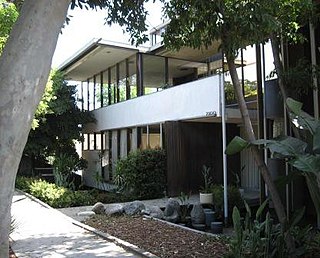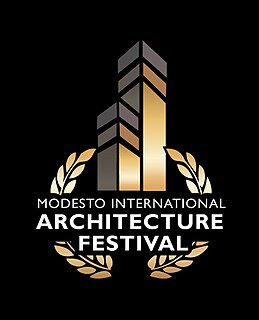
Frank Owen Gehry,, FAIA is a Canadian-born American architect and designer. A number of his buildings, including his private residence in Santa Monica, California, have become world-renowned attractions.

Richard Joseph Neutra was a Jewish Austrian-American architect. Living and building for the majority of his career in Southern California, he came to be considered among the most prominent and important modernist architects. He mainly built suburban single-family detached homes for wealthy clients.

Modern architecture, or modernist architecture, was an architectural movement or architectural style based upon new and innovative technologies of construction, particularly the use of glass, steel, and reinforced concrete; the idea that form should follow function (functionalism); an embrace of minimalism; and a rejection of ornament. It emerged in the first half of the 20th century and became dominant after World War II until the 1980s, when it was gradually replaced as the principal style for institutional and corporate buildings by postmodern architecture.

The Case Study Houses were experiments in American residential architecture sponsored by Arts & Architecture magazine, which commissioned major architects of the day, including Richard Neutra, Raphael Soriano, Craig Ellwood, Charles and Ray Eames, Pierre Koenig, Eero Saarinen, A. Quincy Jones, Edward Killingsworth, and Ralph Rapson to design and build inexpensive and efficient model homes for the United States residential housing boom caused by the end of World War II and the return of millions of soldiers.

Postmodern architecture is a style or movement which emerged in the 1960s as a reaction against the austerity, formality, and lack of variety of modern architecture, particularly in the international style advocated by Philip Johnson and Henry-Russell Hitchcock. The movement was introduced by the architect and urban planner Denise Scott Brown and architectural theorist Robert Venturi in their book Learning from Las Vegas. The style flourished from the 1980s through the 1990s, particularly in the work of Scott Brown & Venturi, Philip Johnson, Charles Moore and Michael Graves. In the late 1990s, it divided into a multitude of new tendencies, including high-tech architecture, neo-futurism, new classical architecture and deconstructivism.

Mid-century modern (MCM) is an American design movement in interior, product, graphic design, architecture, and urban development that was popular from roughly 1945 to 1969, during the United States's post–World War II period. The term was used descriptively as early as the mid-1950s and was defined as a design movement by Cara Greenberg in her 1984 book Mid-Century Modern: Furniture of the 1950s. It is now recognized by scholars and museums worldwide as a significant design movement. The MCM design aesthetic is modern in style and construction, aligned with the Modernist movement of the period. It is typically characterized by clean, simple lines and honest use of materials, and it generally does not include decorative embellishments.
Buff, Straub and Hensman is an architectural firm. The office has won more than 30 awards for house designs from the American Institute of Architects. The firm was known as Buff and Hensman when Cal Straub moved to Arizona and later Buff, Smith and Hensman when Dennis Smith bought the practice after Don Hensman's retirement.
American modernism, much like the modernism movement in general, is a trend of philosophical thought arising from the widespread changes in culture and society in the age of modernity. American modernism is an artistic and cultural movement in the United States beginning at the turn of the 20th century, with a core period between World War I and World War II. Like its European counterpart, American modernism stemmed from a rejection of Enlightenment thinking, seeking to better represent reality in a new, more industrialized world.

Julius Shulman was an American architectural photographer best known for his photograph "Case Study House #22, Los Angeles, 1960. Pierre Koenig, Architect." The house is also known as the Stahl House. Shulman's photography spread the aesthetic of California's Mid-century modern architecture around the world. Through his many books, exhibits and personal appearances his work ushered in a new appreciation for the movement beginning in the 1990s.
Arts & Architecture (1929–1967) was an American design, architecture, landscape, and arts magazine. It was published and edited by John Entenza from 1938–1962 and David Travers 1962–1967. Arts & Architecture played a significant role both in Los Angeles's cultural history and in the development of West Coast modernism in general. The magazine's significant cultural contributions include its sponsorship of the Case Study Houses design-build-publication program.

Early architectural photographers include Roger Fenton, Francis Frith, Samuel Bourne ,Inclined Studio (India) and Albert Levy. They paved the way for the modern speciality of architectural photography. Later architectural photography had practitioners such as Ezra Stoller and Julius Shulman. Stoller worked mainly on the east coast of America, having graduated with a degree in architecture in the 1930s. Shulman, who was based on the West Coast, became an architectural photographer after some images that he had taken of one of Richard Neutra's houses in California made their way onto the architect's desk.

The Kaufmann Desert House, or simply the Kaufmann House, is a house located in Palm Springs, California, that was designed by architect Richard Neutra in 1946. It was commissioned by Edgar J. Kaufmann, Snr, a businessman who also commissioned Fallingwater by Frank Lloyd Wright.

Calvin Chester Straub FAIA was an American architect who had significant impact on architecture as both a designer and an educator. His modesty, confidence, passion for life, and no-nonsense approach resonated with a generation that, like himself, came of age in the World War II era. His influence extended through four subsequent generations as a popular professor of Architecture.
The Cal Poly Pomona College of Environmental Design (CENV) is a college part of the California State Polytechnic University, Pomona. The college houses over 1,600 students; making it one of largest environmental design programs in the United States. The college offers bachelor's degrees in five departments, as well as three master's degree programs. It offers a Master of Interior Architecture, professional degree in collaboration with the University of California, Los Angeles (UCLA).

Neutra VDL Studio and Residences, the home of architect Richard Neutra, is located in Los Angeles, California. It is also known as the Neutra Research House, the Van der Leeuw House, the Richard and Dion Neutra VDL Research House II, or the Richard and Dion Neutra VDL Research Houses and Studio. It was designed by Richard Neutra and his son Dion Neutra. The house is currently owned by California State Polytechnic University, Pomona, and is maintained by its College of Environmental Design. The property was added to the National Register of Historic Places in 2009, and was designated as a National Historic Landmark in 2016.
Juergen Nogai is a German architecture, art and documentary photographer.

The Modesto International Architecture Festival was established to promote and celebrate the architecture profession.
Julius Ralph Davidson or JR Davidson (1889-1977) was a Mid-century modern American architect known for advancing modern architecture in Los Angeles and participating in Arts & Architecture magazine's Case Study House Program.

Horace Gifford was a celebrated beach house architect of the Sixties, Seventies and early Eighties. He led the modernist transformation of New York's Fire Island, in a career that produced sixty three homes across Fire Island and fifteen more further afield. These beach houses were a lesson in sustainable design before green building was in vogue. They are generally modest in size, artfully wedded to their sites and wrought in now-weathered cedar and glass. Gifford died in 1992 of complications from AIDS. Though critically praised and published during his lifetime, Horace Gifford was nearly forgotten until 2013, when architect and historian Christopher Rawlins published "Fire Island Modernist: Horace Gifford and the Architecture of Seduction." Fire Island Modernist combines the genres of monograph, biography, and social history to describe the operatic arc of Gifford's life and times:
As the 1960s became The Sixties, architect Horace Gifford executed a remarkable series of beach houses that transformed the terrain and culture of New York's Fire Island. Growing up on the beaches of Florida, Gifford forged a deep connection with coastal landscapes. Pairing this sensitivity with jazzy improvisations on modernist themes, he perfected a sustainable modernism in cedar and glass that was as attuned to natural landscapes as to our animal natures. Gifford's serene 1960s pavilions provided refuge from a hostile world, while his exuberant post-Stonewall, pre-AIDS masterpieces orchestrated bacchanals of liberation.
Gifford is proof that American Modernism wasn't a single austere style after all; it gave a public voice to a surprising range of communities and ideas.

The Villa Hermosa is a mid-century modern private complex in the Old Las Palmas neighborhood of Palm Springs, California, United States. Located at 155 W Hermosa Place, near North Palm Canyon Drive and West El Alameda, it was originally commissioned as a residential hotel for winter visitors by C.K. Fulton in 1946. The property was featured in photos by Julius Shulman in 1947, and subsequently recognized locally as historically significant.














